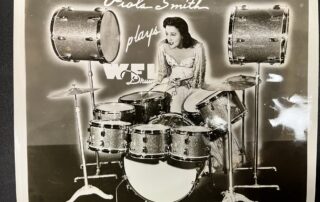She was a vaudeville performer, fashion icon, radio star, and an exotic musical performer. Norman Gillland brings us the story of the small town Wisconsin girl who became an international celebrity.
What do Madonna, Beyoncé, and Miss Piggy have in common?
Well, they and many others followed in the footsteps of a charismatic, talented, and vaguely exotic singer who also went by just one name. Unlike some others, she came by her stage name and her faint accent honestly. Hildegarde Loretta Sell, was born in Adell, Wisconsin, in 1906 into a German-American family. When the Sells moved to Milwaukee, Hildegarde enrolled in the School of Music at Marquette University intending to become a concert pianist. But after seeing a Vaudeville act—four women playing four baby grand pianos at the same time—she decided to become an entertainer.
She joined a troupe of touring performers, playing the piano in the pit orchestra. Her life took another turn when she met Anna Sosenko in a New Jersey boardinghouse. Sosenko was a burgeoning songwriter, andfor Hildegarde she wrote a bilingual ditty that would make the singer famous from coast to coast. In 1935, for Pathé Pictorial, Hildegarde went on-camera and recorded “Darling, Je Vous Aime Beaucoup.”
At Sosenko’s suggestion, Hildegarde started wearing elegant gowns and shoulder-length gloves when she performed. When the two undertook a European tour, Sosenko reported to newspapers back in the States that important people on the Continent had become enthralled by the American chanteuse. Suddenly Hildegarde was an international celebrity.
The leading columnist of the day, Walter Winchell, dubbed her “The Incomparable Hildegarde” and Eleanor Roosevelt would later call her “The First Lady of Supper Clubs.” She had a Top 10 radio show and traveled with her own orchestra. Her admirers included King Gustaf of Sweden and the Duke of Windsor.
By April 17, 1939, when Life magazine put her face on its cover, only one word was necessary—Hildegarde.
During World War II, she scored another hit with an English-language cover of a 1939 German song that had become a favorite of both Axis and Allied soldiers.
She was so popular that Revlon introduced a Hildegarde shade of lipstick and nail polish, and a nursery developed a Hildegarde Rose.
A young pianist, also from Milwaukee, went to see her often when she was playing the Empire Room at the Palmer House in Chicago. He admired her flashy entrances, flamboyant playing, and lavish costumes, and when he launched his career, he, too, went by just one name—Liberace.
Endorsements and investments kept Hildegarde financially secure well after her fame had peaked, and a sense of humor must have helped to keep her healthy. “Miss Piggy got the gloves idea from me,” she joked. During a lifetime that lasted just six months short of a hundred years, Hildegarde never married, but she left a rich showbiz legacy that many performers continue to draw from today.











